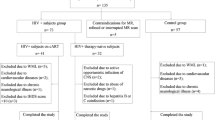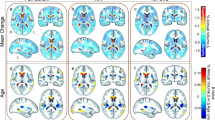Abstract
Conventional magnetic-resonance (MR) imaging is not sensitive enough in depicting subtle neurodegenerative changes that occur during chronic HIV infection with good peripheral viral suppression. The aim of this study was to compare brain volumes in HIV-positive subjects with age- and education-matched healthy controls with regard to influence of aging and immunologic parameters. An overall of 65 subjects (40 HIV-positive and 25 age-, gender-, and education-matched healthy subjects) underwent conventional MR imaging with three-dimensional sequence adequate for volumetric measurements. Volumes of specific brain regions were measured and compared between HIV-positive and healthy subjects using Student t test. Correlations between obtained brain volumes and immunologic parameters were determined using Pearson’s correlation test. Influence of age as a covariate was determined using ANCOVA test. Statistical value was set at p < 0.05. Volumes of nucleus accumbens (p = 0.003), putamen (p = 0.003), and thalamus (p = 0.046) were significantly decreased in HIV-positive subjects compared with healthy, while volumes of lateral ventricles were significantly increased (p = 0.043). However, influence of age on atrophy was greater than presence of HIV infection in all observed volumes. Positive correlation of nadir CD4+ count and nucleus accumbens volume was obtained, as well as of therapy with lateral ventricle volumes. Volumes of putamen correlated negatively with duration of therapy. HIV-associated atrophic changes are visible in nucleus accumbens, putamen, and thalamus in neurocognitively asymptomatic stage, while no changes can be observed in the hippocampus, affected by other types of dementias. Under therapy, the influence of physiological aging on HIV-associated atrophy is greater than the presence of HIV infection per se.




Similar content being viewed by others
References
Ances BM, Ortega M, Vaida F, Heaps J, Paul R (2012) Independent effects of HIV, aging, ad HAART on brain volumetric measures. J Acquir Immune Defic Syndr 59:469–477
Antinori A, Arendt G, Becker JT, Brew BJ, Byrd DA, Cherner M, Clifford DB, Cinque P, Epstein LG, Goodkin K, Gisslen M, Grant I, Heaton RK, Joseph J, Marder K, Marra CM, McArthur JC, Nunn M, Price RW, Pulliam L, Robertson KR, Sacktor N, Valcour V, Wojna VE (2007) Updated research nosology for HIV-associated neurocognitive disorders. Neurology 69:1789–1799
Avci G, Loft S, Sheppard DP, Woods SP, The HIV Neurobehavioral Research Program (HNRP) Group (2016) The effects of HIV disease and older age on laboratory-based, naturalistic, and self-perceived symptoms of prospective memory: does retrieval cue type and delay interval matter? Neuropsychol Dev Cogn B Aging Neuropsychol Cogn 23:716–743
Becker JT, Maruca V, Kingsley LA et al (2011) Factors affecting brain structure in men with HIV disease in the post-HAART era. Neuroradiology 54:113–121
Boban J, Kozic D, Turkulov V, Ostojic J, Semnic R, Lendak D, Brkic S (2017a) HIV-associated neurodegeneration and neuroimmunity: multivoxel MR spectroscopy study in drug-naive and treated patients. Eur Radiol 27(10):4218–4236
Boban J, Kozic D, Turkulov V, Lendak D, Bjelan M, Semnic M, Brkic S (2017b) Proton chemical shift imaging study of the combined antiretroviral therapy on Neurometabolic parameters in chronic HIV infection. AJNR Am J Neuroradiol 38(6):1122–1129
Bryant AK, Ellis RJ, Umlauf A, Gouaux B, Soontornniyomkij V, Letendre SL, Achim CL, Masliah E, Grant I, Moore DJ (2015) Antiretroviral therapy reduces neurodegeneration in human immunodeficiency virus infection. AIDS 29:323–330
Chang L, Andres M, Sadino J, Jiang CS, Nakama H, Miller E, Ernst T (2011) Impact of apolipoprotein E epsilon4 and HIV on cognition and brain atrophy: antagonistic pleiotropy and premature brain aging. NeuroImage 58:1017–1027
Clifford KM, Samboju V, Cobigo Y, et al (2018) Progressive brain atrophy despite persistent viral suppression in HIV over age 60. J Acquir Immune Defic Syndromes doi:https://doi.org/10.1097/QAI.000001489. (in press)
Cohen RA, Harezlak J, Schifitto G et al (2010) Effects of nadir CD4 count and duration of human immunodeficiency virus infection on brain volumes in the highly active antiretroviral therapy era. J Neuro-Oncol 16:25–32
Cole JH, Underwood J, Caan MWA, de Francesco D, van Zoest R, Leech R, Wit FW, Portegies P, Geurtsen GJ, Schmand BA, Schim van der Loeff M, Franceschi C, Sabin CA, Majoie CB, Winston A, Reiss P, Sharp DJ, COBRA Collaboration (2017) Increased brain-predicted aging in treated HIV disease. Neurology 88(4):1349–1357
Didic M, Barbeau EJ, Felician O, Tramoni E, Guedj E, Poncet M, Ceccaldi M (2011) Which memory system is impaired first in Alzheimer's disease? J Alzheimers Dis 27(1):11–22
Ellis RJ, Deutsch R, Heaton RK, Marcotte TD, McCutchan JA, Nelson JA, Abramson I, Thal LJ, Atkinson JH, Wallace MR, Grant I (1997) Neurocognitive impairment is an independent risk factor for death in HIV infection. Arch Neurol 54(4):416–424
Ellis RJ, Badiee J, Vaida F, Letendre S, Heaton RK, Clifford D, Collier AC, Gelman B, McArthur J, Morgello S, McCutchan J, Grant I, CHARTER Group (2011) CD4 nadir is a predictor of HIV neurocognitive impairment in the era of combination antiretroviral therapy. AIDS 25(14):1747–1751
Grahn JA, Parkinosn JA, Owen AM (2008) The cognitive functions of the caudate nucleus. Prog Neurobiol 86(3):144–155
Heaton RK, Franklin DR, Ellis RJ et al (2011) HIV-associated neurocognitive disorders before and during the era of combination antiretroviral therapy: differences in race, nature and predictors. J Neuro-Oncol 17(1):3–16
Hilal S, Amin SM, Venketasubramanian N, Niessen WJ, Vrooman H, Wong TY, Chen C, Ikram MK (2015) Subcortical atrophy in cognitive impairment and dementia. J Alzheimers Dis 48(3):813–823
Jayadev S, Garden G (2009) Host and viral factors influencing the pathogenesis of HIV-associated neurocognitive disorders. J NeuroImmune Pharmacol 4(2):175–189
Manjon J, Coupe P (2016) VolBrain: an online MRI brain Volumetry system. Front Neuroinform 10:30–43
Nie X, Sun Y, Wan S, Zhao H, Liu R, Li X, Wu S, Nedelska Z, Hort J, Qing Z, Xu Y, Zhang B (2017) Subregional structural alterations in hippocampus and nucleus accumbens correlate with the clinical impairment in patients with Alzheimer’s disease clinical spectrum: parallel combining volume and vertex-based approach. Front Neurol 8:399
Pfefferbaum A, Rosenbloom MJ, Sassoon SA, Kemper CA, Deresinski S, Rohlfing T, Sullivan EV (2012) Regional brain structural dysmorphology in huma immunodeficiency virus infection: effects of acquired immune deficiency syndrome, alcoholism and age. Biol Psychiatry 72:361–370. https://doi.org/10.1016/j.biopsych.2012.02.018
Pruessner JC, Li LM, Series W et al (2000) Volumetry of hippocampus and amygdala with high-resolution MRI and three-dimensional analysis software: minimizing the discrepancies between laboratories. Cereb Cortex 10(4):433–442
Raz N, Lindenbrger U, Rodrigue KM et al (2005) Regional brain changes in aging healthy adults: general trends, individual differences and modifiers. Cereb Cortex 15:1676–1689
Rugg MD, Yonelinas AP (2003) Human recognition memory: a cognitive neuroscience perspective. Trends Cogn Sci 7(7):313–319
Salgado S, Kaplitt M, Milchael G (2015) The nuccleus accumbens: a comprehensive review. Stereotact Funct Neurosurg 93(2):75–93
Scott JC, Woods SP, Carey CL et al (2011) Neurocognitive consequences of HIV infection in older adults: an evaluation of the “cortical” hypothesis. AIDS Behav 15:1187–1196
Sheppard DP, Iudicello JE, Morgan EE et al (2017) Accelerated and accentuated neurocognitive aging in HIV infection. J Neuro-Oncol 23:492–500. https://doi.org/10.1007/s13365-017-0523-2
Shikuma CM, Nakamoto B, Shiramizu B, Liang CY, DeGruttola V, Bennett K, Paul R, Kallianpur K, Chow D, Gavegnano C, Hurwitz SJ, Schinazi RF, Valcour VG (2012) Antiretroviral monocyte efficacy score linked to cognitive impairment in HIV. Antivir Ther 17(7):1233–1242
Tate DF, DeLong A, McCaffrey DE, Kertesz K, Paul RH, Conley J, Russell T, Coop K, Gillani F, Flanigan T, Tashima K, Hogan JW (2011) Recent clinical history and cognitive dysfunction for attention and executive function among human immunodeficiency virus-infected patients. Arch Clin Neuropsychol 26(7):614–623
Thompson PM, Dutton RA, Hayashi KM, Toga AW, Lopez OL, Aizenstein HJ, Becker JT (2005) Thinning of the cerebral cortex visualized in HIV/AIDS reflects CD4+ T lymphocyte decline. Proc Natl Acad Sci U S A 102:15647–15652
Towgood KJ, Pirkanen M, Kulasegaram R et al (2012) Mapping the brain in younger and older asymptomatic HIV-1 men: frontal volume changes in the absence of other cortical or diffusion tensor abnormalities. Cortex 48:230–241
Tyler IK, Wright P, Randall B et al (2010) Reorganization of syntactic processing following left hemisphere brain damage: does right hemisphere activity preserve function? Brain 133:3396–3408
Vassalo M, Fabre R, Durant J et al (2017) A decreasing CD4/CD8 ratio over time and lower CSF-penetrating antiretroviral regimens are associated with a higher risk of neurocognitive deterioration, indepently of viral replication. J Neuro-Oncol 23(2):216–225
Yi H-A, Moller C, Dieleman N et al (2016) Relation between subcortical grey matter atrophy and conversion from mild cognitive impairment to Alzheimer’s disease. J Neurol Neurosurg Psychiatry 87(4):425–432
Funding
This research was conducted with the grants of Provincial Secretariat for Science and Technological Development of Vojvodina, grants No. 142-451-2486/2016-01 and 114.451-2514/2015-02.
Author information
Authors and Affiliations
Corresponding author
Ethics declarations
Conflict of interest
The authors declare that they have no conflict of interest.
Rights and permissions
About this article
Cite this article
Tesic, T., Boban, J., Bjelan, M. et al. Basal ganglia shrinkage without remarkable hippocampal atrophy in chronic aviremic HIV-positive patients. J. Neurovirol. 24, 478–487 (2018). https://doi.org/10.1007/s13365-018-0635-3
Received:
Revised:
Accepted:
Published:
Issue Date:
DOI: https://doi.org/10.1007/s13365-018-0635-3




